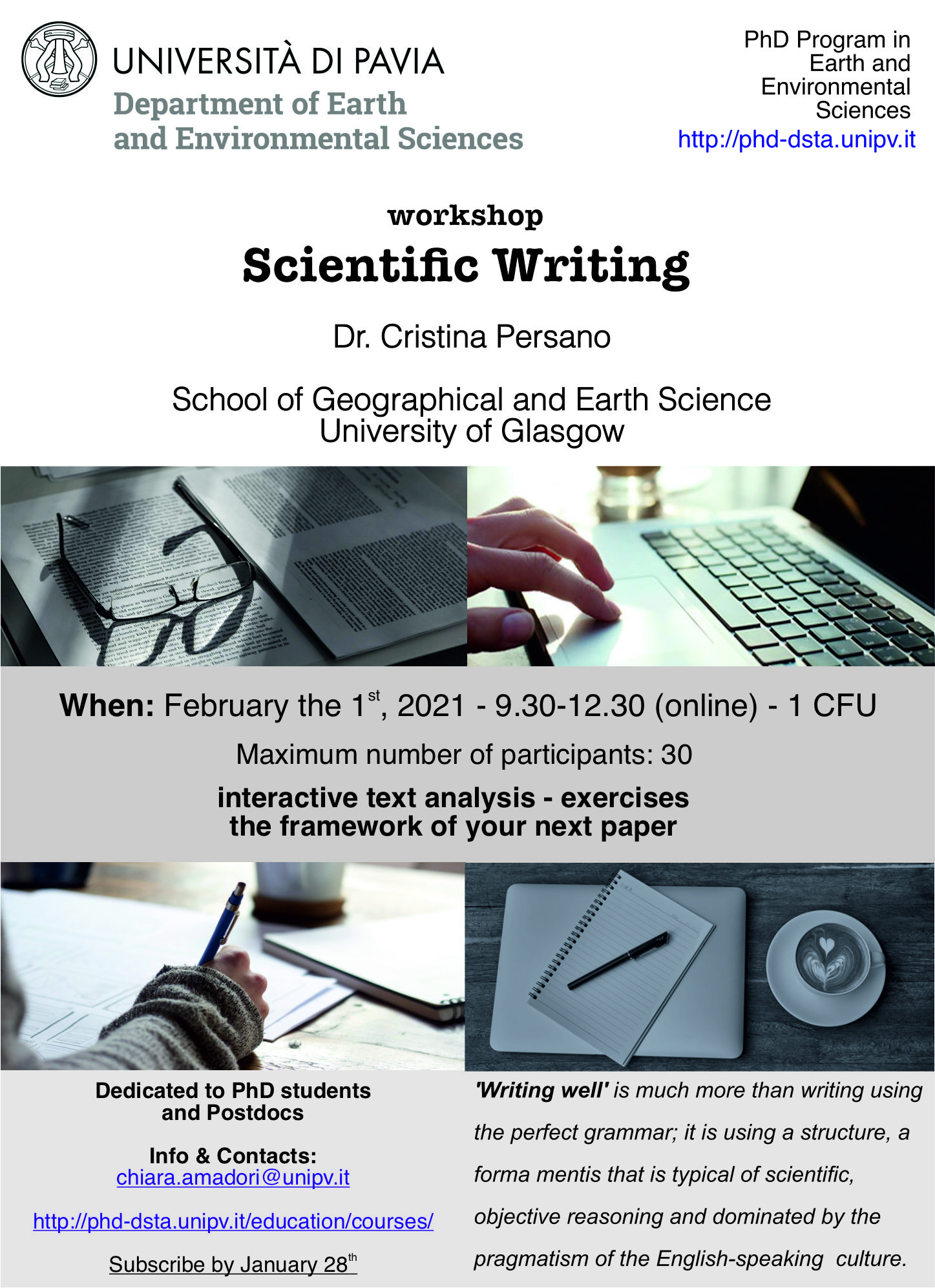Scientific Writing – February 1st, 2021
Scientific Writing
Tutor: Dr. Cristina Persano
Associate Professor, School of Geographical and Earth Science, University of Glasgow, Scotland, UK
Teaching Assistant: Dr. Chiara Amadori
Post-doc at Det. Earth and Environmental Sciences, University of Pavia, Italy
Contact
E-mail: cristina.persano@glasgow.ac.uk ; chiara.amadori@unipv.it
When: February the 1st, 2021 – 3 hour lecture
Maximum number of participants: 30
Rationale of the workshop
Every academic had a paper rejected, nonnative-English speakers sometimes on the basis that the paper is not ‘well-written’; still the paper is grammatically correct. ‘Writing well’ is much more than writing using the perfect grammar; it is using a structure, a forma mentis that is typical of scientific, objective reasoning and dominated by the pragmatism of the English-speaking culture. This structure is hidden in any good paper you may find; it repeats itself, almost invariant in any piece of scientific writing, but, to the non-trained eye, is hidden, sometimes frustrating, as the rules to follow seem to escape us.
Aims and objectives
This workshop aims at showing the participant this ‘hidden’ structure, which permeates any scientific paper at any scale, from the overall composition of the work (introduction – settings – results – discussion – conclusions) to the construction of paragraphs and the use of appropriate adjectives.
The workshop is interactive; you will work in small groups of 3 or 4 people; the end- product is the framework of your next paper. The workshop is online.
Programme
Structure of the workshop and intended learning outcomes
Pre-workshop. You will be asked to select a paper from the journals Geology or Science that is particularly relevant to your research topic; read the paper as you would normally. Write down 3 points that you think make this paper particularly good. This activity can be done at any time and it should not take you more than 2 hours.
Activity 1 (~1/2 hour): this activity aims at ‘revealing’ the structure of the introduction of the paper. Working in groups and under the guidance of the tutors, you will analyse the structure of the introduction, identify objective and subjective statements. This activity introduces you to scientific writing, as a technique based on conciseness, objectivity, and clarity. The introduction is fundamental in your paper. There is an English saying that recites: I do not need to eat the entire egg to know that it is not good.
Activity 2 (~1/2 hour): this activity aims at analyzing the link between the introduction and the settings, or background paragraph, where the study area or the specific question is explained. This activity reflects on ‘how to sell you paper’, how to make it sound relevant to the international community, rather than to the specialized reader.
Coffee break (20 minutes): let us chat together
Activity 3 (~ ½ hour): we will focus on the difference between results and discussion. No paper that mix the presentation of the data with their interpretation will pass any reviewer. You will work with a dataset and you will describe it; the aim of this exercise is to learn how not include the interpretation of the data into the description
Activity 4 (~1/2 hour): discussion and conclusions. This activity has two main objectives: we will reflect on the use of the literature and on the structure of the conclusions.
Activity 5 (40 minutes): going forward. Now, let us think that you want to write your next paper. Where do you start? We will discuss the choice of figures and how to build the text around them.
This final activity will be qualitatively evaluated

